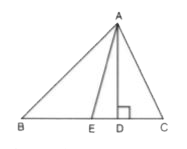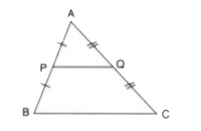In a △OAB,E is the mid point of OB and D is the point on AB such that AD:DB=2:1 If OD and AE intersect at P then determine the ratio of OP:PD using vector methods
To solve the problem using vector methods, we will follow these steps:
Step 1: Define the Points in Vector Form
Let:
- O be the origin, represented by the vector →O=→0.
- A be represented by the vector →A.
- B be represented by the vector →B.
Since E is the midpoint of OB, we can express E as:
→E=→O+→B2=→B2
Step 2: Find the Position Vector of Point D
Point D divides AB in the ratio AD:DB=2:1. Using the section formula, the position vector of D can be calculated as:
→D=2→B+1→A2+1=2→B+→A3
Step 3: Find the Position Vector of Point P
Next, we need to find the intersection point P of lines OD and AE.
1. The line OD can be expressed parametrically as:
→R1=t→D=t(2→B+→A3)=t(2→B+→A)3
2. The line AE can be expressed as:
→R2=s→E+(1−s)→A=s(→B2)+(1−s)→A=s→B2+(1−s)→A
Step 4: Equate the Two Position Vectors
Setting →R1=→R2:
t(2→B+→A)3=s→B2+(1−s)→A
Step 5: Compare Coefficients
From the equation, we can separate the coefficients of →A and →B:
1. Coefficient of →A:
t3=1−s(1)
2. Coefficient of →B:
2t3=s2(2)
Step 6: Solve the System of Equations
From equation (2):
s=4t3
Substituting s into equation (1):
t3=1−4t3
t3+4t3=1
5t3=1⟹t=35
Now substituting t back to find s:
s=4⋅353=45
Step 7: Find the Ratio OP:PD
Using the values of t and s:
- OP corresponds to t and PD corresponds to 1−t:
OP:PD=t:(1−t)=35:(1−35)=35:25=3:2
The final ratio of OP:PD is:
3:2
Let:
- O be the origin, represented by the vector →O=→0.
- A be represented by the vector →A.
- B be represented by the vector →B.
→E=→O+→B2=→B2
Point D divides AB in the ratio AD:DB=2:1. Using the section formula, the position vector of D can be calculated as:
→D=2→B+1→A2+1=2→B+→A3
Next, we need to find the intersection point P of lines OD and AE.
→R1=t→D=t(2→B+→A3)=t(2→B+→A)3
→R2=s→E+(1−s)→A=s(→B2)+(1−s)→A=s→B2+(1−s)→A
Setting →R1=→R2:
t(2→B+→A)3=s→B2+(1−s)→A
From the equation, we can separate the coefficients of →A and →B:
1. Coefficient of →A:
t3=1−s(1)
2t3=s2(2)
From equation (2):
s=4t3
t3=1−4t3
t3+4t3=1
5t3=1⟹t=35
s=4⋅353=45
Using the values of t and s:
- OP corresponds to t and PD corresponds to 1−t:
OP:PD=t:(1−t)=35:(1−35)=35:25=3:2
3:2
Similar Questions
In a triangle ABC,D is the mid - point of BC, AD is produced upto E so that DE = AD.
Prove that :
AB=EC
View SolutionIn a triangle ABC, E is the mid-point of median AD. Show that ar (BED)=14ar (ABC)
View SolutionIn triangle ABC, AB > AC. E is the mid-point of BC and AD is perpendicular to BC. Prove that : AB2+AC2=2AE2+2BE2

View SolutionIn an equilateral triangle ABC , D is the mid-point of AB and E is the mid-point of AC. Find the ratio between ar (△ABC):ar(△ADE)
View SolutionIn the △OAB, M is the midpoint of AB, C is a point on OM, such that 2OC=CM. X is a point on the side OB such that OX = 2XB. The line XC is produced to meet OA in Y. Then OYYA=
View SolutionABC is a triangle in which D is the mid-point of BC and E is the mid-point of AD. Prove that area of BED=14areaofABC.
View SolutionABC is a triangle in which D is the mid-point of BC and E is the mid-point of AD. Prove that area of BED=14area of ABC.
View SolutionIn triangle ABC, P is mid-point of AB and Q is mid-point of AC. If AB = 9.6 cm, BC = 11 cm and AC = 11.2 , find the perimeter of the trapezium PBCQ.

View SolutionIn triangle ABC, D is a point in side AB such that AB = 4AD and E is a point in AC such that AC = 4AE. Show that BC : DE = 4:1
View SolutionIn triangle ABC, M is mid-point of AB, N is mid-point of AC and D is any point in base BC. Use Intercept Theorem to show that MN bisects AD.
View Solution
